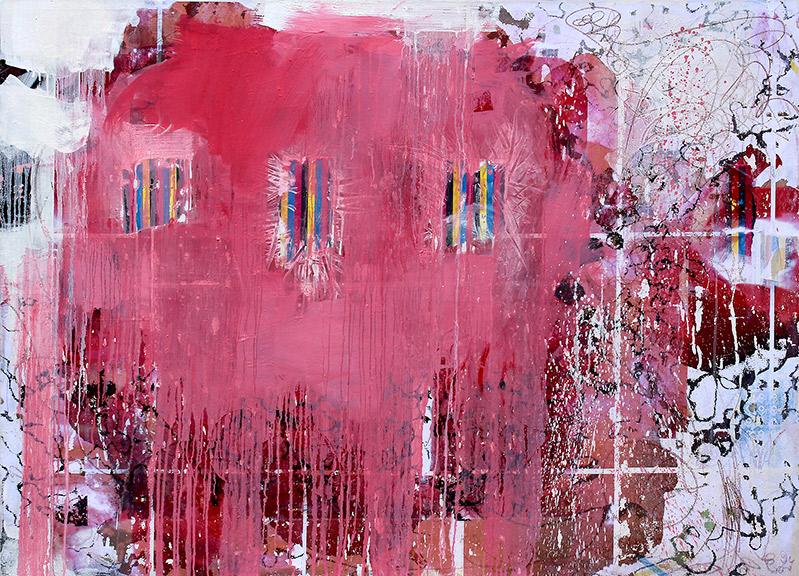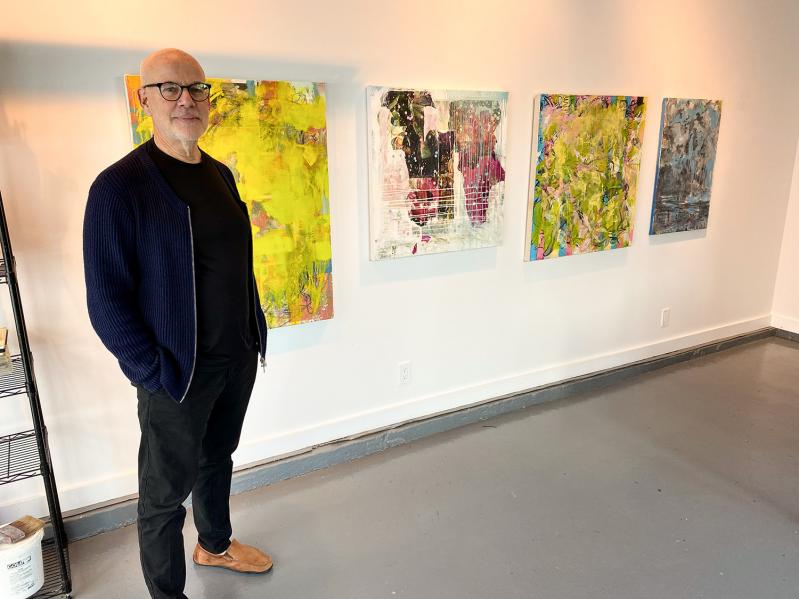When he was a 3-year-old living in a suburb of Minneapolis, John Haubrich picked up a pencil and began to draw. "My parents put up a tiny table in the kitchen and two little chairs, and I would sit at that table and draw all the time," he recalled during a conversation at his house in Springs. For Christmas and birthdays, his parents gave him art supplies, and by the time he was in high school he had progressed to watercolors and oils.
Today, Mr. Haubrich is a painter with many shows on his resume. He is also the full-time art director at Fordham University and the proprietor of Haubrich Art, an exhibition space launched in his studio in August 2021. To ensure that sleep is in short supply, he takes liberal arts courses at Fordham and does freelance design work for clients on the East End.
By 1977, when he earned an associate of arts degree from Normandale College in Bloomington, Minn., he was five years into a series of black-and-white photorealistic paintings of urban scenes and movie stars. It was not until 1986 that he decided to try color.
"It was a big leap, because I was so comfortable in black-and-white, but I was able to do it. I've always thought those 14 years of doing monochromatic work really prepared me for understanding value and tone and shadow, so I could move into color and still do that photorealistic work."
That last observation might surprise a visitor to his studio and house, the walls of which are hung not with photorealism, but with complex, colorful abstract paintings. Perhaps more surprising is that, while for years the public and dealers were seeing only the realism, the artist had been doing abstraction "on the side."
The abstract work actually goes back to ninth grade, when Mr. Haubrich studied the art of Robert Rauschenberg. Rauschenberg figured out how to transfer photographs to another surface by soaking them in turpentine, then placing them face down on paper or canvas and rubbing across the back of the printed image.
Years after high school, Mr. Haubrich had a fortuitous accident. He was at his drafting table when some gel medium, which is used to thicken acrylic paint and give it gloss, landed on the table, and a copy of The New York Times Magazine fell on top of it. When he pulled the magazine off, he saw that the image had transferred to the gel medium.
"I thought, this is fantastic, I don't have to use turpentine, I don't have to breathe fumes, I can just use this material." The process became an integral part of his abstract work. He prints out a photograph, places gel on the canvas, coats the image with gel, and slaps it on the canvas face down.
"I let it dry, then let water run over it, take a sponge and scraper, and peel the paper off." He then paints over the transferred image, which is a mirror image of the original. "It's all chance," he said. "I never know what I'm going to get, or how much of the image" will be transferred.

In Mr. Haubrich's abstract paintings, tension exists between the images and the varying layers of paint, thin or thick, that cover them. Moreover, his handling of paint, first allowing it to drip, then scratching and shellacking the surfaces, results in dynamic compositions that vibrate with energy, simultaneously revealing and concealing the transferred photographs.
At Normandale College, Mr. Haubrich majored in studio art. After graduation, he was working, unhappily, in a clothing store when he met his first partner. "He was the creative director at an ad agency in Minneapolis, and he encouraged me to go into what was then known as keylining, or paste-up work."
In the late 1970s, the artist began working for ad agencies, publishing firms, and magazines, mostly doing keyline production and product illustrations. "It became more creative over time, and I could go home and make art at night." Graphic design and art direction have been his day job ever since.
After moves to St. Petersburg, Fla., and Denver, he returned to Minneapolis in 1986, where "I started meeting people who were either going back and forth to New York or planning to move there." A year later, on his first trip to the city, he showed slides of his photorealistic work to galleries in SoHo.
The Stricoff Gallery on Broome Street was receptive, but its schedule was full, and the owner, Gloria Stricoff, suggested he contact them in a year. "I took her card and flew back to Minnesota, but when I got home I couldn't find it. So I took a 5 a.m. flight to New York the next day, and went to the gallery" to pick up a new card.
It was worth the time and expense. Mr. Haubrich kept in touch with the gallery, and sent them images of paintings of architectural signage, such as old Rexall drug stores and bars. Ms. Stricoff requested the Rexall painting and sold it. A successful five-year run with the gallery followed.
Mr. Haubrich moved to New York permanently in 1992, and met Ed Krug, now his husband, two years later. He'd already begun visiting the East End, and in 1996 the couple bought their first house in East Hampton.
Once here, he showed at the Chrysalis and Hampton Road galleries, both in Southampton; Ille Arts in Amagansett, the Sara Nightingale gallery in Sag Harbor, and many others, as well as in group exhibitions in New York, Los Angeles, and other big cities.
Fordham hired Mr. Haubrich in 2011; since then, he has designed large-scale graphics for buildings on both its Rose Hill and Lincoln Center campuses. As the university's art director, he oversees photo shoots, directs the digital library, and handles the marketing of important events, among them the annual Founders Dinner, a benefit that raises several million dollars for student scholarships.
After a few years at Fordham, he decided to complete his undergraduate degree there. "Because it's a Jesuit school, you have to take philosophy, ethics, religion, a language course, and other liberal arts courses that teach you how to think critically. It's been a lot of work and a lot of years," but he is now only 10 credits shy of a B.A.
The renovation of his garage into a studio was the genesis for Haubrich Art. "I always wanted to have a gallery," he said, "but I'd never done it." Then, the lightning strike: "Why don't I just say, 'I have a gallery?' "
The first show, "Cakes," which opened in August 2021, featured colorful, whimsical paintings of cakes by Adriana Barone, a Sag Harbor artist. The opening drew more than 100 visitors and resulted in many sales. Convinced there was a market for reasonably priced artwork, Mr. Haubrich has mounted four more shows since then, with work by Christa Maiwald, Pat Place, George Singer, and Gus Yero, as well as his own and Ms. Barone's.
Haubrich Art is on hiatus for the winter, but has lined up several shows for next year, including one by Gabriele Raacke in August and a pop-up at a friend's house in September.
Mr. Haubrich still paints representationally from time to time. "I did the Springs General Store and some bodies of water out here. It sort of intrigues me still, but the abstract work is just much more fun."
He paused reflectively. "At the same time, I put a landscape into a show at the Salmagundi Club in New York, and it won first prize."




